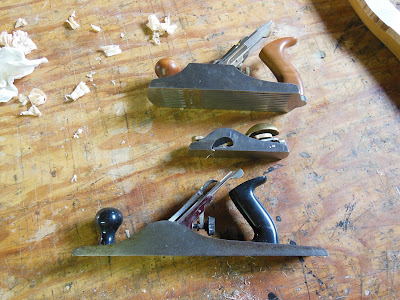As I will be gluing the sound-board together in this next step, it seems an appropriate place to stop and talk a little bit about glue. Many restorers and conservators talk very negatively, and vehemently so, about AR, or Aliphatic Resin, glues. One major complaint about this type of glue is that it creeps, and that joints under constant stress will eventually fail. In thirty years of cabinet making, over ninety modern sound-boards, and two new modern instruments, one weighing over 2000 lbs., I have yet to see a single joint fail as a result of creep, although I am well aware that there are others who do not share this experience. In every case where I have replaced a modern sound-board, the original board failed as the result of the use of animal glues. One other often cited problem is that joints made with AR glues are not invisible. Let me assure you, that properly constructed joints assembled with AR glue, are as invisible as they would be with any other adhesive.
Having said this, however, I would add that I believe the use of AR glues, in making copies of historical instruments, and in instrument restoration, is inappropriate for many reasons, the foremost, for me, being one of aesthetics. But wait, you say, weren't all those sound-boards, mentioned in the preceding paragraph, very likely to become antiques themselves one day, given enough time. Yes, you are right, and the point is well taken, and yet we mustn't overthink the point. All I can say about this is that I have no criticism for anyone who can say that they did their best, with the knowledge and tools available.
On this project I will be using hot hide glue, in future posts I will refer to this simply as hide glue. Not to be confused with liquid hide, or any other type. The stuff I'm using is 376 gram Bloom strength, pictured above, (this strength is measured with a device called, I kid you not, a Gelometer) it has many qualities that recommend it for this type of job. It is the same, or very similar to the type originally used, it is very reversible, especially when the joint was recently assembled, unless hydrated it is usually brittle, and will fail before the surrounding wood, which can be advantageous.
At room temperature hide glue has a relatively short open time, around one minute at 70°F after which the glue begins to gel, and will no longer create an effective bond. This property, however, needn't be seen as a drawback, hide glue in its hydrated state can easily be reactivated with a little heat. In the case of small joints, Violin tops for instance, a small amount of warm water brushed on the joint is sufficient to reactivate the glue, and swell the joint together. On other joints, a warm clothes iron or heating pads can be useful. This allows for the careful positioning, and re-positioning of tricky assemblies.




Comments
Post a Comment